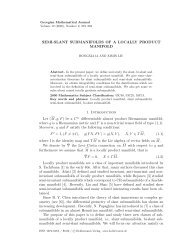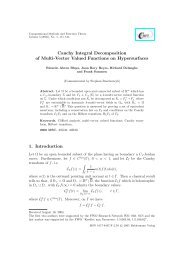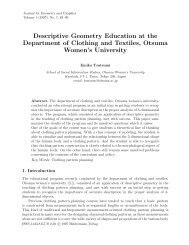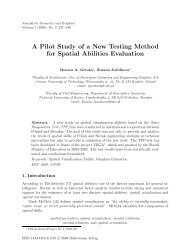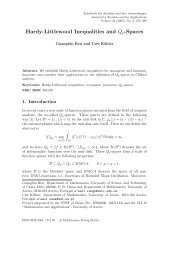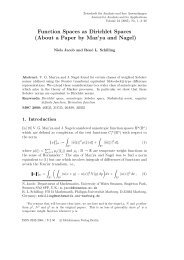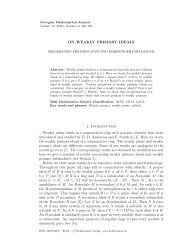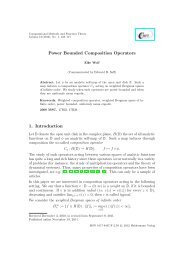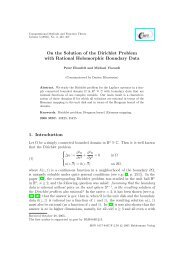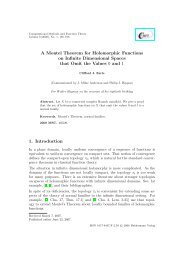Schwarz-Christoffel Formula for Multiply Connected Domains
Schwarz-Christoffel Formula for Multiply Connected Domains
Schwarz-Christoffel Formula for Multiply Connected Domains
Create successful ePaper yourself
Turn your PDF publications into a flip-book with our unique Google optimized e-Paper software.
12 (2012), No. 2 <strong>Schwarz</strong>-<strong>Christoffel</strong> <strong>Formula</strong> <strong>for</strong> <strong>Multiply</strong> <strong>Connected</strong> <strong>Domains</strong> 453<br />
4. Reduction of the Riemann-Hilbert problem to<br />
functional equations<br />
It follows from [15] that the inhomogeneous Riemann-Hilbert problem (2) always<br />
has solutions. The general solution amounts of a particular solution of the inhomogeneous<br />
problem and a linear combination of n solutions of the homogeneous<br />
problem.<br />
In order to solve the problem (2) rewrite it in the <strong>for</strong>m of the R-linear problem<br />
(13)<br />
(t − a k )ψ(t) = (t − a k )ψ k (t) − (t − a k )ψ k (t) − 1 + iξ k ,<br />
|t − a k | = r k , k = 1, . . . , n.<br />
Here, ξ k are undetermined real constants, ψ k (z) is analytic in |z − a k | < r k ,<br />
continuous in |z − a k | ≤ r k except the points z lk , where<br />
(14) ψ k (z) ∼<br />
β lk<br />
2(z − z lk )<br />
as z → z lk .<br />
It will be shown below in Lemma 1 that the asymptotics (14) and (5) <strong>for</strong> ψ(z)<br />
are matched. Hence, the R-linear problem (13) must be stated in a class of<br />
functions with prescribed singularities. It is convenient to describe this class by<br />
introduction of the Banach spaces as follows.<br />
Let G be a domain on the extended complex plane. Introduce the Banach space<br />
C(∂G) of functions continuous on ∂G with the norm<br />
‖F ‖ = max |F (t)|.<br />
t∈∂G<br />
Let us consider a closed subspace C A (G) of C(∂G) consisting of functions analytically<br />
continued into G. The Maximum Principle implies that convergence in<br />
the space C A (G) is equivalent to uni<strong>for</strong>m convergence in the closure of G. Let<br />
a fixed function F 0 have a finite number of singularities on the boundary ∂G.<br />
Introduce the space<br />
of functions endowed with the norm<br />
C A (G, F 0 ) = {F : F − F 0 ∈ C A (G)}<br />
‖F ‖ CA (G,F 0 ) = max<br />
t∈∂G |F (t) − F 0(t)|.<br />
The spaces C A (G, F 0 ) and C A (G) are isomorphic.<br />
Introduce mutually disjointed disks<br />
D k = {z ∈ C: |z − a k | < r k }, k = 1, 2, . . . , n.<br />
The multiply connected domain D complements all the closed disks D k ∪ L k to<br />
the extended complex plane Ĉ = C ∪ {∞}, i.e.<br />
n<br />
D = Ĉ\ ⋃<br />
(D k ∪ L k ).<br />
k=1



